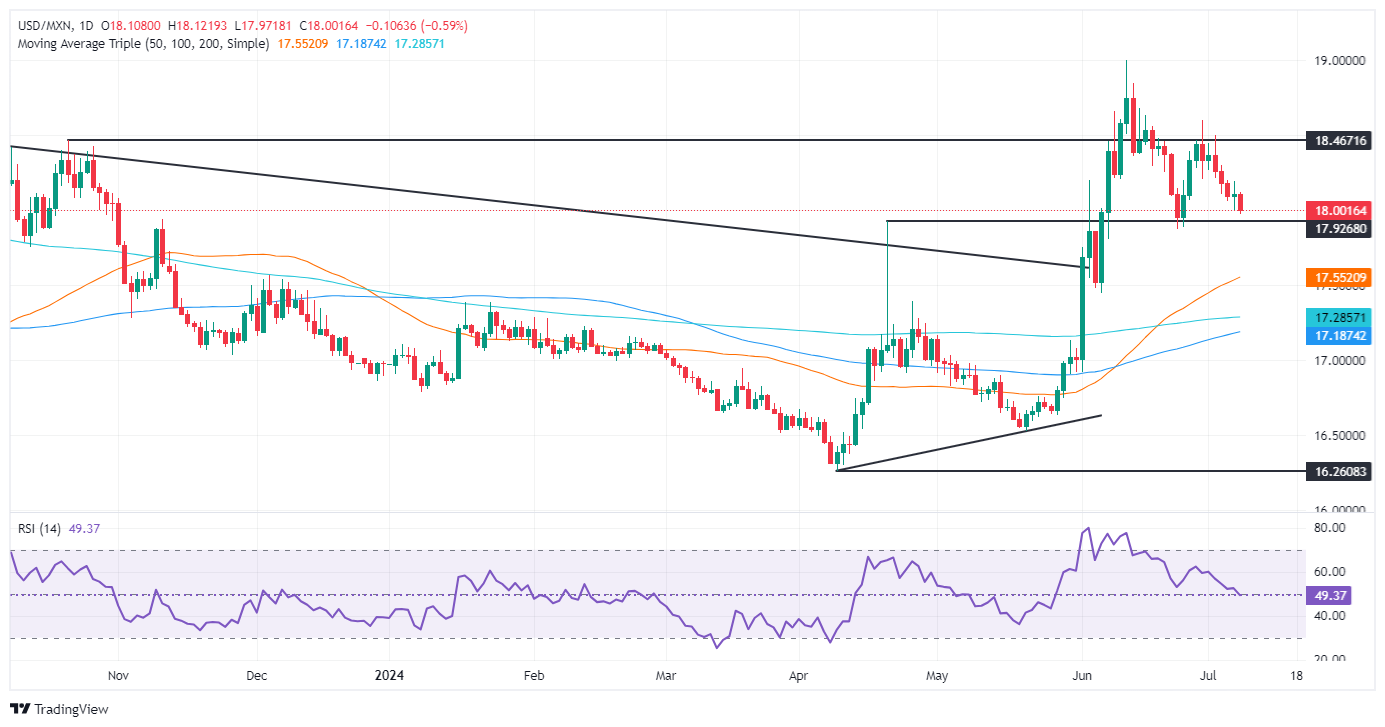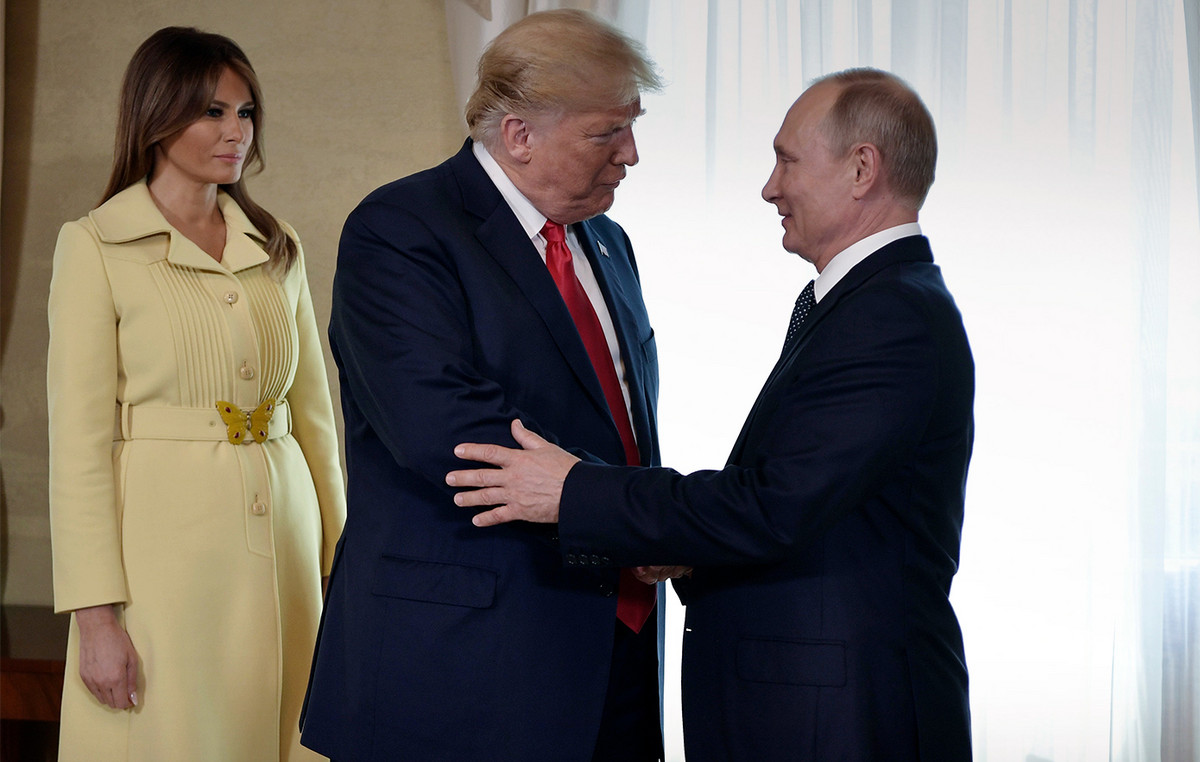- The Mexican Peso soars as the USD/MXN falls below 18.00 and hits its lowest level since June 25.
- The June CPI report, consumer confidence and industrial production will shape Mexico’s economic outlook.
- Banxico’s minutes will likely signal patience on rate cuts amid stable inflation expectations.
The Mexican Peso surged sharply against the US Dollar as the USD/MXN fell below the psychological figure of 18.00 on Monday, a level last seen on June 25. This signaled that Peso buyers remain engaged in the so-called “carry trade,” which supports the Mexican currency. The pair is therefore trading at 17.99, down 0.45%.
Mexico’s economic agenda will be of interest to traders. The focus is the Consumer Price Index (CPI) report for June, due out on July 9. More data will be released, such as consumer confidence and industrial production, which will dictate the economic trend and is expected to slow, according to analysts.
On Thursday, the Bank of Mexico (Banxico) will release the minutes of its latest monetary policy meeting, which are expected to show that the central bank will remain patient in reducing borrowing costs.
Across the border, the New York Federal Reserve revealed that consumer inflation expectations were lowered from 3.2% to 3% for one year. In addition, market participants will be focused on Federal Reserve (Fed) Chairman Jerome Powell’s speech in the US Congress on Tuesday and Wednesday and the publication of June inflation figures.
Last week’s US jobs data sparked speculation that the Fed could ease policy in September, according to data from the CME FedWatch tool. The odds of a September cut stand at 73%, up from 71% last Friday.
Market drivers: Mexican peso rises further despite USD strength
- The Banxico survey showed that economists estimate that the Gross Domestic Product (GDP) will end the year at 2%, compared to 2.1%. They expect Banxico to reduce rates from 11.00% to 10.25%, compared to the 10.00% projected in May.
- Some analysts in Mexico estimate that the economy could slow down but avoid a recession, according to the National Statistics Agency (INEGI) Coincident Indicator. Despite that, they said that the reforms promoted by President Andrés Manuel López Obrador (AMLO), particularly the judicial reform, could affect the country’s creditworthiness.
- Mexico’s CPI is expected to rise to 4.84% in June from 4.69% year-on-year, while core CPI is estimated to decline to 4.15% year-on-year from 4.21%.
- US CPI is forecast to decline to 3.1% from 3.3% in the 12 months to June, while core inflation is projected to remain firm at 3.4% year-on-year.
- The US Dollar Index (DXY), which tracks the value of a basket of six currencies against the US dollar, is holding firm at 104.94, up 0.06%.
Technical Analysis: Mexican Peso remains near weekly highs as USD/MXN hovers around 18.00 level
USD/MXN hit a nine-day low of 17.97, although some bids below 18.00 lifted the pair above the latter. The Dollar remains weak against the Peso. Momentum has shifted in favor of sellers, with the RSI on the verge of falling below the neutral line of 50.
If the USD/MXN manages a daily close below 18.00, the next support would be the June 24 low of 17.87. Further losses lie below at the 50-day simple moving average (SMA) at 17.56, followed by the 200-day SMA at 17.26. The next support level would be the 100-day SMA at 17.17.
For a bullish resumption, USD/MXN needs to clear 18.10, followed by a rally above the June 28 high of 18.59, so that buyers can challenge the yearly high of 18.99. Conversely, sellers will need a drop below 18.00, which could extend the pair’s decline towards the December 5 high, which turned support at 17.56, followed by the 50-day simple moving average (SMA) at 17.37.
Mexican Peso FAQs
The Mexican Peso is the legal currency of Mexico. The MXN is the most traded currency in Latin America and the third most traded currency in the Americas. The Mexican Peso is the first currency in the world to use the $ sign, prior to the later use of the Dollar. The Mexican Peso or MXN is divided into 100 cents.
Banxico is the Bank of Mexico, the country’s central bank. Created in 1925, it provides the national currency, the MXN, and its primary objective is to preserve its value over time. In addition, the Bank of Mexico manages the country’s international reserves, acts as a lender of last resort to the banking sector, and provides economic and financial advice to the government. Banxico uses the tools and techniques of monetary policy to achieve its objective.
When inflation is high, the value of the Mexican Peso (MXN) tends to decrease. This implies an increase in the cost of living for Mexicans, which affects their ability to invest and save. In general, inflation affects the Mexican economy because Mexico imports a significant amount of final consumer products, such as gas, fuel, food, clothing, etc., and a large amount of production inputs. On the other hand, the higher the inflation and debt, the less attractive the country is for investors.
The exchange rate between the USD and the MXN affects imports and exports between the United States and Mexico, potentially affecting demand and trade flows. The price of the Dollar against the Mexican Peso is affected by factors such as monetary policy, interest rates, the consumer price index, economic growth and some geopolitical decisions.
The exchange rate between the USD and the MXN affects imports and exports between the United States and Mexico, potentially affecting demand and trade flows. The price of the Dollar against the Mexican Peso is affected by factors such as monetary policy, interest rates, the consumer price index, economic growth and some geopolitical decisions.
Source: Fx Street
I am Joshua Winder, a senior-level journalist and editor at World Stock Market. I specialize in covering news related to the stock market and economic trends. With more than 8 years of experience in this field, I have become an expert in financial reporting.








